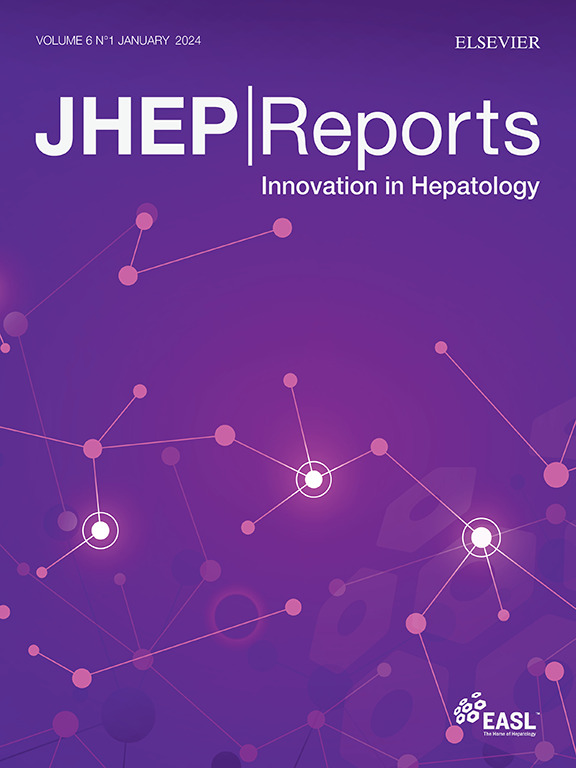Biliary atresia susceptibility gene EFEMP1 regulates extrahepatic bile duct elastic fiber formation and mechanics
IF 9.5
1区 医学
Q1 GASTROENTEROLOGY & HEPATOLOGY
引用次数: 0
Abstract
Background & Aims
EGF-containing fibulin extracellular matrix protein 1 (EFEMP1, also called fibulin-3) is an extracellular matrix protein linked in a genome-wide association study to biliary atresia, a fibrotic disease of the neonatal extrahepatic bile duct. Fibulin-3 is deposited in most tissues and Efemp1 null mice have decreased elastic fibers in visceral fascia; however, fibulin-3 does not have a role in the development of large elastic fibers and its overall function in the extrahepatic bile ducts remains unclear.
Methods
We used staining and histology to define the amount and organization of key extracellular matrix components in the extrahepatic bile ducts. We also repurposed pressure myography, a technique heretofore applied to the vasculature, to determine the contribution of elastin and fibulin-3 to extrahepatic bile duct mechanics. We examined extrahepatic bile duct structure and mechanics in three models: neonatal vs. adult rat ducts (n = 6 each), elastase-treated adult rat ducts (n = 6-7 each), and Efemp1+/- vs. wild-type mouse ducts (n = 6 each).
Results
We demonstrated that fibulin-3 is expressed in the submucosa of both neonatal and adult mouse, rat and human extrahepatic bile ducts and that, in adult Efemp1+/- mouse ducts, elastin organization into fibers is decreased by approximately half. Pressure myography showed that Efemp1+/- ducts have altered mechanics compared to control ducts, with Efemp1+/- ducts displaying significant stretch compared to controls (p = 0.0376); these changes in stretch are similar to those observed in elastase-treated vs. normal ducts (p <0.0001) and in neonatal ducts vs. adult ducts (p <0.0001).
Conclusion
Fibulin-3 has an important role in the formation of elastic fibers and the mechanical properties of the extrahepatic bile duct. This provides functional relevance for the biliary atresia susceptibility gene EFEMP1.
Impact and implications:
The gene EFEMP1 was found via a genome-wide association study to be a susceptibility gene for the neonatal disease biliary atresia. EFEMP1 encodes the protein fibulin-3, which regulates elastic fiber organization in the extrahepatic bile duct (EHBD), the major site of disease in biliary atresia. We showed that neonatal EHBDs as well as mice heterozygous for Efemp1 have decreased numbers of elastic fibers, and that this alters EHBD mechanics. This work is important for understanding the mechanism of biliary atresia, in particular susceptibility to obstruction.

胆道闭锁易感基因EFEMP1调控肝外胆管弹性纤维形成及力学。
背景与目的:egf -含纤维蛋白细胞外基质蛋白1 (EFEMP1,也称为纤维蛋白-3)是一种细胞外基质蛋白,在全基因组关联研究中与新生儿肝外胆管纤维化疾病胆道闭锁相关。纤维蛋白-3沉积在大多数组织中,Efemp1缺失小鼠内脏筋膜弹性纤维减少;然而,纤维蛋白-3在大弹性纤维的形成中没有作用,其在肝外胆管中的整体功能尚不清楚。方法:采用染色法和组织学方法确定肝外胆管中关键细胞外基质成分的数量和组织结构。我们还重新利用压力肌图,一种迄今为止应用于血管系统的技术,来确定弹性蛋白和纤维蛋白-3对肝外胆管力学的贡献。我们在三种模型中检测了肝外胆管的结构和力学:新生大鼠与成年大鼠胆管(n = 6),弹性酶处理的成年大鼠胆管(n = 6-7), Efemp1 +/-与野生型小鼠胆管(n = 6)。结果:我们发现,在新生和成年小鼠、大鼠和人肝外胆管的粘膜下层都有纤维蛋白-3的表达,而在成年Efemp1 +/-小鼠胆管中,弹性蛋白在纤维中的组织减少了大约一半。压力肌图显示,与对照组相比,Efemp1 +/-导管的力学改变,Efemp1 +/-导管与对照组相比显着拉伸(p = 0.0376);结论:纤维蛋白-3在肝外胆管弹性纤维的形成和力学性能方面起着重要作用。这为胆道闭锁易感基因EFEMP1提供了功能相关性。影响和启示:基因EFEMP1是通过全基因组关联研究发现的新生儿疾病胆道闭锁的易感基因。EFEMP1编码蛋白纤维蛋白-3,其调节肝外胆管(EHBD)的弹性纤维组织,而肝外胆管是胆道闭锁的主要疾病部位。我们发现新生儿EHBD以及Efemp1杂合小鼠的弹性纤维数量减少,这改变了EHBD的机制。这项工作对了解胆道闭锁的机制,特别是对梗阻的易感性具有重要意义。
本文章由计算机程序翻译,如有差异,请以英文原文为准。
求助全文
约1分钟内获得全文
求助全文
来源期刊

JHEP Reports
GASTROENTEROLOGY & HEPATOLOGY-
CiteScore
12.40
自引率
2.40%
发文量
161
审稿时长
36 days
期刊介绍:
JHEP Reports is an open access journal that is affiliated with the European Association for the Study of the Liver (EASL). It serves as a companion journal to the highly respected Journal of Hepatology.
The primary objective of JHEP Reports is to publish original papers and reviews that contribute to the advancement of knowledge in the field of liver diseases. The journal covers a wide range of topics, including basic, translational, and clinical research. It also focuses on global issues in hepatology, with particular emphasis on areas such as clinical trials, novel diagnostics, precision medicine and therapeutics, cancer research, cellular and molecular studies, artificial intelligence, microbiome research, epidemiology, and cutting-edge technologies.
In summary, JHEP Reports is dedicated to promoting scientific discoveries and innovations in liver diseases through the publication of high-quality research papers and reviews covering various aspects of hepatology.
 求助内容:
求助内容: 应助结果提醒方式:
应助结果提醒方式:


